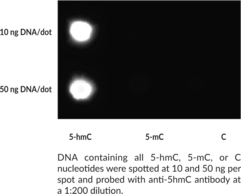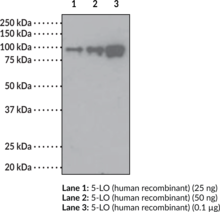Cayman
Showing 6601–6750 of 45550 results
-
5-hydroxy-Nω-methyl Tryptamine is a metabolite of serotonin (5-HT; Item No. 14332) in humans that has also been found in plants.{48185,31973,42693} It is an agonist of the 5-HT receptor subtype 5-HT7 (IC50 = 23 pM in a radioligand binding assay).{31973} 5-hydroxy-Nω-methyl Tryptamine increases intracellular cyclic AMP production in HEK293 cells expressing 5-HT7 (EC50 = 22 nM). It inhibits serotonin uptake in HEK293 cells expressing human serotonin transporters (IC50 = 490 nM). Elevated levels of urinary 5-hydroxy-Nω-methyl tryptamine have been found in patients with schizophrenia, depression, and epilepsy.{48185}
Brand:CaymanSKU:20047 -Available on backorder
5-hydroxymethyl Tolterodine is an active metabolite of the muscarinic acetylcholine receptor antagonists tolterodine (Item No. 15027) and fesoterodine (Item No. 23777).{47319} It is formed from tolterodine by the cytochrome P450 (CYP) isoform CYP2D6 and from fesoterodine by plasma esterases.{47320,47319} 5-hydroxymethyl Tolterodine inhibits M1-5 muscarinic receptors with Ki values of 2.3, 2, 2.5, 2.8, and 2.9 nM, respectively, for the human receptors expressed in CHO cells.{47321} It selectively inhibits acetylcholine-induced bladder contraction over electrically induced salivation in anesthetized cats (ID50s = 15 and 40 nmol/kg, respectively).
Brand:CaymanSKU:27833 - 1 mgAvailable on backorder
5-Hydroxymethyl-2-furancarboxylic acid is the main metabolite of 5-hydroxymethyl-2-furfural, a product of acid-catalyzed degradation of sugars during the heating and storage of foods that influences taste and physiological functions in the body.{38681} 5-Hydroxymethyl-2-furancarboxylic acid can be used as a building block in the enzymatic synthesis of macrocyclic oligoesters.{38682}
Brand:CaymanSKU:22999 - 1 gAvailable on backorder
5-Hydroxymethyl-2-furancarboxylic acid is the main metabolite of 5-hydroxymethyl-2-furfural, a product of acid-catalyzed degradation of sugars during the heating and storage of foods that influences taste and physiological functions in the body.{38681} 5-Hydroxymethyl-2-furancarboxylic acid can be used as a building block in the enzymatic synthesis of macrocyclic oligoesters.{38682}
Brand:CaymanSKU:22999 - 10 gAvailable on backorder
5-Hydroxymethyl-2-furancarboxylic acid is the main metabolite of 5-hydroxymethyl-2-furfural, a product of acid-catalyzed degradation of sugars during the heating and storage of foods that influences taste and physiological functions in the body.{38681} 5-Hydroxymethyl-2-furancarboxylic acid can be used as a building block in the enzymatic synthesis of macrocyclic oligoesters.{38682}
Brand:CaymanSKU:22999 - 5 gAvailable on backorder
5-Hydroxymethyl-2-furancarboxylic acid is the main metabolite of 5-hydroxymethyl-2-furfural, a product of acid-catalyzed degradation of sugars during the heating and storage of foods that influences taste and physiological functions in the body.{38681} 5-Hydroxymethyl-2-furancarboxylic acid can be used as a building block in the enzymatic synthesis of macrocyclic oligoesters.{38682}
Brand:CaymanSKU:22999 - 500 mgAvailable on backorder
Brand:CaymanSKU:18289- 1 eaAvailable on backorder
Brand:CaymanSKU:18289- 1 ea5-Hydroxymethylcytosine (5-hmC) is an epigenetic modification formed from the oxidation of 5-methylcytosine by Tet dioxygenases.{17171} 5-hmC is primarily a stable DNA modification, but it can be oxidized by Tet enzymes and its products further modified to generate nonmethylated cytosine, indicating a role as an intermediate in DNA demethylation as well.{49667,29364,49668} It is associated with actively transcribed genes and recognized by a variety of proteins, including proteins involved in DNA repair and DNA metabolic processes.{49667,49668} 5-hmC has been found in all mammalian tissues but levels are higher in the brain relative to other tissues.{49669} The percentage of genomic 5-hmC in mouse cerebellum increases during postnatal development until adulthood, and genes acquiring intragenic 5-hmC are enriched in pathways associated with age-related neurodegenerative disease pathways in adult mice.{20327} In contrast, 5-hmC levels are reduced by up to 8-fold in cancer tissues.{49667,49670} Cayman’s 5-Hydroxymethylcytosine Polyclonal Antibody can be used for dot blot and ELISA applications.
Brand:CaymanSKU:18289 - 1 eaAvailable on backorder
5-Hydroxymethylfurfural is a furanic compound derived from the degradation of sugars.{45315,45316,38681,45317} It can be derived from reducing sugars via acid-catalyzed degradation or the Maillard reaction during the heating and storage of foods.{45316,38681} 5-Hydroxymethylfurfural is an intermediate in the synthesis of a variety of compounds including 2,5-diformylfuran (DFF), 2,5-furandicarboxylic acid (FDA), 2,5-bis(hydroxymethyl)furan (5-(hydroxymethyl)furfuryl alcohol; Item No. 20658), and dimethylfuran (DMF), among others.{45317} 5-Hydroxymethylfurfural has been found in the marine algae L. undulata and scavenges 2,2-diphenyl-1-picrylhydrazyl (DPPH; Item No. 14805), hydroxyl, alkyl, and superoxide radicals in cell-free assays (IC50s = 27.1, 22.8, 45, and 33.5 μM, respectively).{45318}
Brand:CaymanSKU:27835 - 1 gAvailable on backorder
5-Hydroxymethylfurfural is a furanic compound derived from the degradation of sugars.{45315,45316,38681,45317} It can be derived from reducing sugars via acid-catalyzed degradation or the Maillard reaction during the heating and storage of foods.{45316,38681} 5-Hydroxymethylfurfural is an intermediate in the synthesis of a variety of compounds including 2,5-diformylfuran (DFF), 2,5-furandicarboxylic acid (FDA), 2,5-bis(hydroxymethyl)furan (5-(hydroxymethyl)furfuryl alcohol; Item No. 20658), and dimethylfuran (DMF), among others.{45317} 5-Hydroxymethylfurfural has been found in the marine algae L. undulata and scavenges 2,2-diphenyl-1-picrylhydrazyl (DPPH; Item No. 14805), hydroxyl, alkyl, and superoxide radicals in cell-free assays (IC50s = 27.1, 22.8, 45, and 33.5 μM, respectively).{45318}
Brand:CaymanSKU:27835 - 10 gAvailable on backorder
5-Hydroxymethylfurfural is a furanic compound derived from the degradation of sugars.{45315,45316,38681,45317} It can be derived from reducing sugars via acid-catalyzed degradation or the Maillard reaction during the heating and storage of foods.{45316,38681} 5-Hydroxymethylfurfural is an intermediate in the synthesis of a variety of compounds including 2,5-diformylfuran (DFF), 2,5-furandicarboxylic acid (FDA), 2,5-bis(hydroxymethyl)furan (5-(hydroxymethyl)furfuryl alcohol; Item No. 20658), and dimethylfuran (DMF), among others.{45317} 5-Hydroxymethylfurfural has been found in the marine algae L. undulata and scavenges 2,2-diphenyl-1-picrylhydrazyl (DPPH; Item No. 14805), hydroxyl, alkyl, and superoxide radicals in cell-free assays (IC50s = 27.1, 22.8, 45, and 33.5 μM, respectively).{45318}
Brand:CaymanSKU:27835 - 5 gAvailable on backorder
5-IAF is a fluorescent probe for labeling proteins.{48310} It has been used to label proteins through a reaction with sulfhydryl groups. 5-IAF displays excitation/emission maxima of 491/518 nm, respectively, which can shift during protein labeling or changes in hydrophobicity and can be quenched by potassium iodide. 5-IAF has been used to monitor ligand binding and conformational changes of the Na+/K+-ATPase.{48311}
Brand:CaymanSKU:26807 - 100 mgAvailable on backorder
5-IAF is a fluorescent probe for labeling proteins.{48310} It has been used to label proteins through a reaction with sulfhydryl groups. 5-IAF displays excitation/emission maxima of 491/518 nm, respectively, which can shift during protein labeling or changes in hydrophobicity and can be quenched by potassium iodide. 5-IAF has been used to monitor ligand binding and conformational changes of the Na+/K+-ATPase.{48311}
Brand:CaymanSKU:26807 - 25 mgAvailable on backorder
5-IAF is a fluorescent probe for labeling proteins.{48310} It has been used to label proteins through a reaction with sulfhydryl groups. 5-IAF displays excitation/emission maxima of 491/518 nm, respectively, which can shift during protein labeling or changes in hydrophobicity and can be quenched by potassium iodide. 5-IAF has been used to monitor ligand binding and conformational changes of the Na+/K+-ATPase.{48311}
Brand:CaymanSKU:26807 - 50 mgAvailable on backorder
Aminoindans (AI) were originally studied as semi-rigid congeners of phenylethylamines, which are psychoactive alkaloids.{20192,20175} 5-IAI is a psychoactive analog of p-iodoamphetamine and is indistinguishable, in its physiological effects, from 3,4-methylenedioxymethamphetamine in rats.{20233} A single 40 mg/kg dose of 5-IAI significantly reduces both serotonin uptake sites and hippocampal serotonin levels in rats.{20234} This product is intended for forensic applications.
Brand:CaymanSKU:11035 - 10 mgAvailable on backorder
Aminoindans (AI) were originally studied as semi-rigid congeners of phenylethylamines, which are psychoactive alkaloids.{20192,20175} 5-IAI is a psychoactive analog of p-iodoamphetamine and is indistinguishable, in its physiological effects, from 3,4-methylenedioxymethamphetamine in rats.{20233} A single 40 mg/kg dose of 5-IAI significantly reduces both serotonin uptake sites and hippocampal serotonin levels in rats.{20234} This product is intended for forensic applications.
Brand:CaymanSKU:11035 - 5 mgAvailable on backorder
Aminoindans (AI) were originally studied as semi-rigid congeners of phenylethylamines, which are psychoactive alkaloids.{20192,20175} 5-IAI is a psychoactive analog of p-iodoamphetamine and is indistinguishable, in its physiological effects, from 3,4-methylenedioxymethamphetamine in rats.{20233} A single 40 mg/kg dose of 5-IAI significantly reduces both serotonin uptake sites and hippocampal serotonin levels in rats.{20234} This product is intended for forensic applications.
Brand:CaymanSKU:11035 - 50 mgAvailable on backorder
5-Iodotubercidin (Itu) is an adenosine derivative that initiates glycogen synthesis in hepatocytes by causing inactivation of phosphorylase α and activation of glycogen synthase α (maximal effects with ~20 µM Itu).{15220} Itu can inhibit a broad range of PKs including PKA (IC50 = 5-10 µM), phosphorylase kinase (IC50 = 5-10 µM), casein kinase I (IC50 = 0.4 µM) and II (IC50 = 10.9 µM), and PKC (IC50 = 0.4 µM), which appears to account for its glycogenic action.{15083} Itu is also a highly potent inhibitor of ERK2 (Ki = 525 nM), a protein kinase with important roles in cell proliferation.{15221} Mediated by the inhibition of acetyl-CoA carboxylase, Itu increases fatty acid oxidation activity of the liver at the expense of lipogenesis.{15219}
Brand:CaymanSKU:10010375 - 1 mgAvailable on backorder
5-Iodotubercidin (Itu) is an adenosine derivative that initiates glycogen synthesis in hepatocytes by causing inactivation of phosphorylase α and activation of glycogen synthase α (maximal effects with ~20 µM Itu).{15220} Itu can inhibit a broad range of PKs including PKA (IC50 = 5-10 µM), phosphorylase kinase (IC50 = 5-10 µM), casein kinase I (IC50 = 0.4 µM) and II (IC50 = 10.9 µM), and PKC (IC50 = 0.4 µM), which appears to account for its glycogenic action.{15083} Itu is also a highly potent inhibitor of ERK2 (Ki = 525 nM), a protein kinase with important roles in cell proliferation.{15221} Mediated by the inhibition of acetyl-CoA carboxylase, Itu increases fatty acid oxidation activity of the liver at the expense of lipogenesis.{15219}
Brand:CaymanSKU:10010375 - 100 µgAvailable on backorder
5-Iodotubercidin (Itu) is an adenosine derivative that initiates glycogen synthesis in hepatocytes by causing inactivation of phosphorylase α and activation of glycogen synthase α (maximal effects with ~20 µM Itu).{15220} Itu can inhibit a broad range of PKs including PKA (IC50 = 5-10 µM), phosphorylase kinase (IC50 = 5-10 µM), casein kinase I (IC50 = 0.4 µM) and II (IC50 = 10.9 µM), and PKC (IC50 = 0.4 µM), which appears to account for its glycogenic action.{15083} Itu is also a highly potent inhibitor of ERK2 (Ki = 525 nM), a protein kinase with important roles in cell proliferation.{15221} Mediated by the inhibition of acetyl-CoA carboxylase, Itu increases fatty acid oxidation activity of the liver at the expense of lipogenesis.{15219}
Brand:CaymanSKU:10010375 - 250 µgAvailable on backorder
5-Iodotubercidin (Itu) is an adenosine derivative that initiates glycogen synthesis in hepatocytes by causing inactivation of phosphorylase α and activation of glycogen synthase α (maximal effects with ~20 µM Itu).{15220} Itu can inhibit a broad range of PKs including PKA (IC50 = 5-10 µM), phosphorylase kinase (IC50 = 5-10 µM), casein kinase I (IC50 = 0.4 µM) and II (IC50 = 10.9 µM), and PKC (IC50 = 0.4 µM), which appears to account for its glycogenic action.{15083} Itu is also a highly potent inhibitor of ERK2 (Ki = 525 nM), a protein kinase with important roles in cell proliferation.{15221} Mediated by the inhibition of acetyl-CoA carboxylase, Itu increases fatty acid oxidation activity of the liver at the expense of lipogenesis.{15219}
Brand:CaymanSKU:10010375 - 5 mgAvailable on backorder
5-IT is a positional isomer of α-methyltryptamine (Item No. 11135); α-methyltryptamine is a psychedelic drug that is regulated in the United States. 5-IT has been associated with recent deaths.{21528} This product is intended for research and forensic applications.
Brand:CaymanSKU:12042 - 1 mgAvailable on backorder
5-IT is a positional isomer of α-methyltryptamine (Item No. 11135); α-methyltryptamine is a psychedelic drug that is regulated in the United States. 5-IT has been associated with recent deaths.{21528} This product is intended for research and forensic applications.
Brand:CaymanSKU:12042 - 10 mgAvailable on backorder
5-IT is a positional isomer of α-methyltryptamine (Item No. 11135); α-methyltryptamine is a psychedelic drug that is regulated in the United States. 5-IT has been associated with recent deaths.{21528} This product is intended for research and forensic applications.
Brand:CaymanSKU:12042 - 5 mgAvailable on backorder
The enzyme 5-lipoxygenase (5-LO) plays a key role in regulating the production of leukotrienes (LTs).{12243} Overproduction of LTs contributes to several diseases, most notably chronic inflammatory diseases such as asthma, fibrosis,{956} and atherosclerosis. Recent work has demonstrated that the activity of 5-LO is regulated by protein kinase A (PKA) phosphorylation of serine-523 in 5-LO. Under normal conditions, this phosphorylation may be important in limiting inflammation. Abnormal signaling through cAMP and PKA, may therefore contribute to a variety of diseases, including those characterized by chronic inflammation. The phospho-specific antibody to Ser523 on 5-LO provides a valuable tool for studying the role of 5-LO regulation in diseases such as asthma, fibrosis, and atherosclerosis.
Brand:CaymanSKU:10007820 - 1 eaAvailable on backorder
Antigen: phosphopeptide corresponding to amino acid residues surrounding phospho-Ser523 of human 5-LO • Host: rabbit • Cross Reactivity: (+) human, rat, and non-human primate 5-LO • Application: WB • 5-LO activity is regulated by PKA phosphorylation at serine-523. Under normal conditions, this phosphorylation may be important in limiting inflammation.
Brand:CaymanSKU:10007820- 1 eaAvailable on backorder
Antigen: phosphopeptide corresponding to amino acid residues surrounding phospho-Ser523 of human 5-LO • Host: rabbit • Cross Reactivity: (+) human, rat, and non-human primate 5-LO • Application: WB • 5-LO activity is regulated by PKA phosphorylation at serine-523. Under normal conditions, this phosphorylation may be important in limiting inflammation.
Brand:CaymanSKU:10007820- 1 eaImmunogen: Synthetic peptide from an internal region of human 5-lipoxygenase • Host: Rabbit • Species Reactivity: (+) Human and porcine • Cross Reactivity: (–) 12-Lipoxygenase and 15-Lipoxygenase • Applications: WB and immunohistochemistry • MW = 78 kDa
Brand:CaymanSKU:160402- 1 ea5-Lipoxygenase (5-LO) is an enzyme encoded by ALOX5 in humans that is involved in leukotriene biosynthesis.{53405} It is comprised of an N-terminal regulatory domain and a C-terminal catalytic domain and is primarily expressed in leukocytes. Increases in intracellular calcium levels or cellular stress induce translocation of 5-LO from the cytosol or nucleoplasm, depending on the cell type and 5-LO phosphorylation status, to the nuclear envelope, where it interacts with 5-LO-activating protein (FLAP), which transfers arachidonic acid (Item Nos. 90010 | 90010.1 | 10006607) to 5-LO.{53405,53406} 5-LO catalyzes the conversion of arachidonic acid to 5(S)-HpETE (Item No. 44230) and then to leukotriene A4 (LTA4).{53407} Other substrates of 5-LO include 5,8,11,14,17-eicosapentaenoic acid, 5,8,11-eicosatrienoic acid, 5,8-eicosadienoic acid, 12-HpETE, and 15-HpETE. Alox5 knockout mice are protected against arthritis and pulmonary inflammation.{53406} Knockout of Alox5 also protects apolipoprotein E-deficient hyperlipidemic mice from high-fat diet-induced hepatic injury and inflammation.{53408} Levels of 5-LO are elevated in postmortem hippocampus and cortex of patients with Alzheimer’s disease.{53409} Cayman’s 5-Lipoxygenase Polyclonal Antibody can be used for Western blot and immunohistochemistry applications. The antibody recognizes 5-LO at 78 kDa from human and porcine samples.
Brand:CaymanSKU:160402 - 1 eaAvailable on backorder
Immunogen: Synthetic peptide from an internal region of human 5-lipoxygenase • Host: Rabbit • Species Reactivity: (+) Human and porcine • Cross Reactivity: (–) 12-Lipoxygenase and 15-Lipoxygenase • Applications: WB and immunohistochemistry • MW = 78 kDa
Brand:CaymanSKU:160402- 1 eaAvailable on backorder
5-MAPB is an amino-methylated derivative of 5-APB (Item No. 11134), an amphetamine-like designer drug. The physiological and toxicological properties of this compound have not been evaluated. This product is intended for forensic and research purposes.
Brand:CaymanSKU:-5-MAPB is an amino-methylated derivative of 5-APB (Item No. 11134), an amphetamine-like designer drug. The physiological and toxicological properties of this compound have not been evaluated. This product is intended for forensic and research purposes.
Brand:CaymanSKU:-5-MAPB is an amino-methylated derivative of 5-APB (Item No. 11134), an amphetamine-like designer drug. The physiological and toxicological properties of this compound have not been evaluated. This product is intended for forensic and research purposes.
Brand:CaymanSKU:-5-methoxy AMT (5-MeO AMT) is a potent psychoactive analog of 5-methoxy DiPT (Item No. 11865) and α-methyltryptamine (AMT), tryptamine derivatives that inhibit reuptake and stimulate release of monoamines.{19758} 5-MeO AMT inhibits re-uptake (IC50s = 0.18, 2.9, and 3.37 μM) and stimulates release (EC50s = 1.5, 460, and 8.9 μM) of dopamine, serotonin, and norepinephrine, respectively from rat brain synaptosomes.{19758} 5-MeO AMT, sometimes called Alpha-O, has been sold under the guise of LSD and abused as a recreational drug.{21059} This tryptamine analog is intended only to be used to aid the forensic analysis of samples that may contain this compound or for scientific research applications.
Brand:CaymanSKU:11553 - 10 mgAvailable on backorder
5-methoxy AMT (5-MeO AMT) is a potent psychoactive analog of 5-methoxy DiPT (Item No. 11865) and α-methyltryptamine (AMT), tryptamine derivatives that inhibit reuptake and stimulate release of monoamines.{19758} 5-MeO AMT inhibits re-uptake (IC50s = 0.18, 2.9, and 3.37 μM) and stimulates release (EC50s = 1.5, 460, and 8.9 μM) of dopamine, serotonin, and norepinephrine, respectively from rat brain synaptosomes.{19758} 5-MeO AMT, sometimes called Alpha-O, has been sold under the guise of LSD and abused as a recreational drug.{21059} This tryptamine analog is intended only to be used to aid the forensic analysis of samples that may contain this compound or for scientific research applications.
Brand:CaymanSKU:11553 - 25 mgAvailable on backorder
5-methoxy AMT (5-MeO AMT) is a potent psychoactive analog of 5-methoxy DiPT (Item No. 11865) and α-methyltryptamine (AMT), tryptamine derivatives that inhibit reuptake and stimulate release of monoamines.{19758} 5-MeO AMT inhibits re-uptake (IC50s = 0.18, 2.9, and 3.37 μM) and stimulates release (EC50s = 1.5, 460, and 8.9 μM) of dopamine, serotonin, and norepinephrine, respectively from rat brain synaptosomes.{19758} 5-MeO AMT, sometimes called Alpha-O, has been sold under the guise of LSD and abused as a recreational drug.{21059} This tryptamine analog is intended only to be used to aid the forensic analysis of samples that may contain this compound or for scientific research applications.
Brand:CaymanSKU:11553 - 5 mgAvailable on backorder
5-methoxy DALT is a tryptamine derivative recently used as a component in ‘bath salts’ that act directly on monoamine receptors (similar to 3,4-methylenedioxyamphetamine) to produce its psychoactive effects.{19271} The physiological, neurological, and toxicological actions of 5-methoxy DALT have not been fully characterized. This compound is intended as an analytical standard for the forensic analysis of samples that may contain this compound.
Brand:CaymanSKU:10729 - 1 mgAvailable on backorder
5-methoxy DALT is a tryptamine derivative recently used as a component in ‘bath salts’ that act directly on monoamine receptors (similar to 3,4-methylenedioxyamphetamine) to produce its psychoactive effects.{19271} The physiological, neurological, and toxicological actions of 5-methoxy DALT have not been fully characterized. This compound is intended as an analytical standard for the forensic analysis of samples that may contain this compound.
Brand:CaymanSKU:10729 - 10 mgAvailable on backorder
5-methoxy DALT is a tryptamine derivative recently used as a component in ‘bath salts’ that act directly on monoamine receptors (similar to 3,4-methylenedioxyamphetamine) to produce its psychoactive effects.{19271} The physiological, neurological, and toxicological actions of 5-methoxy DALT have not been fully characterized. This compound is intended as an analytical standard for the forensic analysis of samples that may contain this compound.
Brand:CaymanSKU:10729 - 5 mgAvailable on backorder
5-methoxy DBT (Item No. 27465) is an analytical reference standard categorized as a tryptamine.{35727} This product is intended for research and forensic applications.
Brand:CaymanSKU:27465 - 1 mgAvailable on backorder
5-methoxy DBT (Item No. 27465) is an analytical reference standard categorized as a tryptamine.{35727} This product is intended for research and forensic applications.
Brand:CaymanSKU:27465 - 5 mgAvailable on backorder
5-methoxy DiPT is a tryptamine-type designer drug with pronounced psychoactive and physiological effects.{19963} It potently inhibits the re-uptake of monoamines (IC50s = 0.65, 2.2, and 8.2 μM for dopamine, serotonin, and norepinephrine, respectively) while not affecting their release from rat brain synaptosomes.{19758} This product is intended for forensic applications.
Brand:CaymanSKU:-5-methoxy DMT is a naturally-occurring hallucinogenic indolealkylamine that potently activates serotonin (5-HT) receptors.{20184,20687} Although this compound is regulated in many countries, including the United States, it has been described as an ‘emerging psychoactive substance’ found in party pills and related mixtures.{20685} As 5-methoxy DMT is inactivated by monoamine oxidases, inhibitors of monoamine oxidases are often combined with 5-methoxy DMT to prolong its activity.{20686,20688} The pharmacological and toxicological properties of this compound have been recently reviewed.{20690} This product is intended for forensic applications.
Brand:CaymanSKU:11628 - 1 mgAvailable on backorder
5-methoxy MiPT is a psychedelic tryptamine related to N-methyl-N-isopropyltryptamine. It potently inhibits the re-uptake of the monoamines serotonin and norepinephrine (IC50s = 6.4 and 2.6 μM, respectively), but does not affect dopamine re-uptake.{19758} 5-methoxy MiPT has no effect on the release of monoamines from rat brain synaptosomes.{19758} This product is intended for forensic and research applications.
Brand:CaymanSKU:11482 - 10 mgAvailable on backorder
5-methoxy MiPT is a psychedelic tryptamine related to N-methyl-N-isopropyltryptamine. It potently inhibits the re-uptake of the monoamines serotonin and norepinephrine (IC50s = 6.4 and 2.6 μM, respectively), but does not affect dopamine re-uptake.{19758} 5-methoxy MiPT has no effect on the release of monoamines from rat brain synaptosomes.{19758} This product is intended for forensic and research applications.
Brand:CaymanSKU:11482 - 25 mgAvailable on backorder
5-methoxy MiPT is a psychedelic tryptamine related to N-methyl-N-isopropyltryptamine. It potently inhibits the re-uptake of the monoamines serotonin and norepinephrine (IC50s = 6.4 and 2.6 μM, respectively), but does not affect dopamine re-uptake.{19758} 5-methoxy MiPT has no effect on the release of monoamines from rat brain synaptosomes.{19758} This product is intended for forensic and research applications.
Brand:CaymanSKU:11482 - 5 mgAvailable on backorder
5-methoxy Tryptophol (5-MTOH) is a natural indole that is produced by the pineal gland.{33173,33174} It is a product of melatonin metabolism that may be biologically active.{33176,33178} The levels of 5-MTOH in plasma vary in a diurnal pattern in rodents and humans.{33175,33177}
Brand:CaymanSKU:21061 -Out of stock
5-methoxy Tryptophol (5-MTOH) is a natural indole that is produced by the pineal gland.{33173,33174} It is a product of melatonin metabolism that may be biologically active.{33176,33178} The levels of 5-MTOH in plasma vary in a diurnal pattern in rodents and humans.{33175,33177}
Brand:CaymanSKU:21061 -Out of stock
5-methoxy Tryptophol (5-MTOH) is a natural indole that is produced by the pineal gland.{33173,33174} It is a product of melatonin metabolism that may be biologically active.{33176,33178} The levels of 5-MTOH in plasma vary in a diurnal pattern in rodents and humans.{33175,33177}
Brand:CaymanSKU:21061 -Out of stock
5-methoxy-DL-Tryptophan (DL-5-MTP) is an active metabolite of tryptophan with anti-inflammatory and anticancer activities.{54528,54529} It reduces LPS-induced expression of COX-2, TNF-α, IL-1β, and IL-6 in RAW 264.7 macrophages when used at a concentration of 50 mM.{54529} DL-5-MTP (23.4 mg/kg) increases survival in a mouse model of LPS-induced endotoxemia and a mouse model of sepsis induced by cecal ligation and puncture. It also reduces tumor growth and the number of metastases in an A549 mouse xenograft model when administered at a dose of 100 mg/kg.{54528}
Brand:CaymanSKU:31222 - 100 mgAvailable on backorder
5-methoxy-DL-Tryptophan (DL-5-MTP) is an active metabolite of tryptophan with anti-inflammatory and anticancer activities.{54528,54529} It reduces LPS-induced expression of COX-2, TNF-α, IL-1β, and IL-6 in RAW 264.7 macrophages when used at a concentration of 50 mM.{54529} DL-5-MTP (23.4 mg/kg) increases survival in a mouse model of LPS-induced endotoxemia and a mouse model of sepsis induced by cecal ligation and puncture. It also reduces tumor growth and the number of metastases in an A549 mouse xenograft model when administered at a dose of 100 mg/kg.{54528}
Brand:CaymanSKU:31222 - 250 mgAvailable on backorder
5-methoxy-DL-Tryptophan (DL-5-MTP) is an active metabolite of tryptophan with anti-inflammatory and anticancer activities.{54528,54529} It reduces LPS-induced expression of COX-2, TNF-α, IL-1β, and IL-6 in RAW 264.7 macrophages when used at a concentration of 50 mM.{54529} DL-5-MTP (23.4 mg/kg) increases survival in a mouse model of LPS-induced endotoxemia and a mouse model of sepsis induced by cecal ligation and puncture. It also reduces tumor growth and the number of metastases in an A549 mouse xenograft model when administered at a dose of 100 mg/kg.{54528}
Brand:CaymanSKU:31222 - 500 mgAvailable on backorder
α-Ethyltryptamine (α-ET) is a psychoactive compound which is regulated as a Schedule I drug in the United States. 5-methoxy-α-Ethyltryptamine is an analog of α-ET which has recently been abused recreationally.{20500} Its physiological and toxicological properties are poorly studied. This product is intended for research and forensic applications.
Brand:CaymanSKU:-α-Ethyltryptamine (α-ET) is a psychoactive compound which is regulated as a Schedule I drug in the United States. 5-methoxy-α-Ethyltryptamine is an analog of α-ET which has recently been abused recreationally.{20500} Its physiological and toxicological properties are poorly studied. This product is intended for research and forensic applications.
Brand:CaymanSKU:-α-Ethyltryptamine (α-ET) is a psychoactive compound which is regulated as a Schedule I drug in the United States. 5-methoxy-α-Ethyltryptamine is an analog of α-ET which has recently been abused recreationally.{20500} Its physiological and toxicological properties are poorly studied. This product is intended for research and forensic applications.
Brand:CaymanSKU:-5-Methoxycanthinone is an alkaloid that has been found in L. floridana and has anticancer properties.{60001} It is cytotoxic to KB, A549, and HCT-8 cells (EC50s = 2.9, 3.1, and 2.5 µg/ml, respectively). It is active against the P. falciparum mefloquine-resistant strain F32 and the multidrug and chloroquine-resistant strain K1 (IC50s = 10.4 and 5.1 µg/ml, respectively).{60005} However, it increases the parasite load by 68.4% in a mouse model of leishmaniasis when administered at a dose of 10 mg/kg per day.{60006}
Brand:CaymanSKU:31342 - 1 mgAvailable on backorder
5-Methoxycanthinone is an alkaloid that has been found in L. floridana and has anticancer properties.{60001} It is cytotoxic to KB, A549, and HCT-8 cells (EC50s = 2.9, 3.1, and 2.5 µg/ml, respectively). It is active against the P. falciparum mefloquine-resistant strain F32 and the multidrug and chloroquine-resistant strain K1 (IC50s = 10.4 and 5.1 µg/ml, respectively).{60005} However, it increases the parasite load by 68.4% in a mouse model of leishmaniasis when administered at a dose of 10 mg/kg per day.{60006}
Brand:CaymanSKU:31342 - 5 mgAvailable on backorder
5-Methoxyindole-3-acetic acid (5-MIAA) is a methoxyindole that is synthesized in rat pineal gland, retina, and harderian gland.{46703} Following conversion to a peroxyl radical by horseradish peroxidase (HRP), 5-MIAA increases the rate of formation of thiobarbituric acid reactive substances (TBARS) in liposomes and is cytotoxic to V79 hamster cells.{46704,46705} In vivo, 5-MIAA (100 and 200 µg/animal) prolongs the estrous cycle and increases diestrous smears, uterine weight, the number of uterine follicles, and plasma levels of 17β-estradiol (Item No. 10006315) in female rats.{46703}
Brand:CaymanSKU:-5-Methoxyindole-3-acetic acid (5-MIAA) is a methoxyindole that is synthesized in rat pineal gland, retina, and harderian gland.{46703} Following conversion to a peroxyl radical by horseradish peroxidase (HRP), 5-MIAA increases the rate of formation of thiobarbituric acid reactive substances (TBARS) in liposomes and is cytotoxic to V79 hamster cells.{46704,46705} In vivo, 5-MIAA (100 and 200 µg/animal) prolongs the estrous cycle and increases diestrous smears, uterine weight, the number of uterine follicles, and plasma levels of 17β-estradiol (Item No. 10006315) in female rats.{46703}
Brand:CaymanSKU:-5-Methoxyindole-3-acetic acid (5-MIAA) is a methoxyindole that is synthesized in rat pineal gland, retina, and harderian gland.{46703} Following conversion to a peroxyl radical by horseradish peroxidase (HRP), 5-MIAA increases the rate of formation of thiobarbituric acid reactive substances (TBARS) in liposomes and is cytotoxic to V79 hamster cells.{46704,46705} In vivo, 5-MIAA (100 and 200 µg/animal) prolongs the estrous cycle and increases diestrous smears, uterine weight, the number of uterine follicles, and plasma levels of 17β-estradiol (Item No. 10006315) in female rats.{46703}
Brand:CaymanSKU:-5-methyl Chrysene is a carcinogenic polycyclic aromatic hydrocarbon consisting of four fused rings and acts as an aryl hydrocarbon receptor agonist.{30273} It is produced by the incomplete combustion of organic matter and found primarily in gasoline exhaust and tobacco smoke.{30273} 5-methyl Chrysene can be activated to mutagenic metabolites by cytochrome P450 1A1 and 1B1.{30273}
Brand:CaymanSKU:-Available on backorder
5-methyl Chrysene is a carcinogenic polycyclic aromatic hydrocarbon consisting of four fused rings and acts as an aryl hydrocarbon receptor agonist.{30273} It is produced by the incomplete combustion of organic matter and found primarily in gasoline exhaust and tobacco smoke.{30273} 5-methyl Chrysene can be activated to mutagenic metabolites by cytochrome P450 1A1 and 1B1.{30273}
Brand:CaymanSKU:-Available on backorder
5-methyl Chrysene is a carcinogenic polycyclic aromatic hydrocarbon consisting of four fused rings and acts as an aryl hydrocarbon receptor agonist.{30273} It is produced by the incomplete combustion of organic matter and found primarily in gasoline exhaust and tobacco smoke.{30273} 5-methyl Chrysene can be activated to mutagenic metabolites by cytochrome P450 1A1 and 1B1.{30273}
Brand:CaymanSKU:-Available on backorder
5-methyl-2-HOBA is an isoketal scavenger.{40882} It reduces angiotensin II-induced increases in systolic blood pressure in mice.
Brand:CaymanSKU:25351 - 10 mgAvailable on backorder
5-methyl-2-HOBA is an isoketal scavenger.{40882} It reduces angiotensin II-induced increases in systolic blood pressure in mice.
Brand:CaymanSKU:25351 - 25 mgAvailable on backorder
5-methyl-2-HOBA is an isoketal scavenger.{40882} It reduces angiotensin II-induced increases in systolic blood pressure in mice.
Brand:CaymanSKU:25351 - 5 mgAvailable on backorder
5-methyl-2-HOBA is an isoketal scavenger.{40882} It reduces angiotensin II-induced increases in systolic blood pressure in mice.
Brand:CaymanSKU:25351 - 50 mgAvailable on backorder
Brand:CaymanSKU:489334 - 1 eaAvailable on backorder
5-Methyl-2′-deoxycytidine is a pyrimidine nucleoside that when incorporated into single-stranded DNA can act in cis to signal de novo DNA methylation.{26572} It has been used in epigenetics research to investigate the dynamics of DNA methylation pattern in the control of gene expression.{26573}
Brand:CaymanSKU:-5-Methyl-2′-deoxycytidine is a pyrimidine nucleoside that when incorporated into single-stranded DNA can act in cis to signal de novo DNA methylation.{26572} It has been used in epigenetics research to investigate the dynamics of DNA methylation pattern in the control of gene expression.{26573}
Brand:CaymanSKU:-5-Methyl-2′-deoxycytidine is a pyrimidine nucleoside that when incorporated into single-stranded DNA can act in cis to signal de novo DNA methylation.{26572} It has been used in epigenetics research to investigate the dynamics of DNA methylation pattern in the control of gene expression.{26573}
Brand:CaymanSKU:-5-Methylcytidine is a modified nucleoside derived from 5-methylcytosine and is a minor constituent of RNA as well as DNA for certain organisms.{26198,26197} Roughly one to two residues of 5-methylcytidine occur in every 1,000 RNA residues.{26200} It has been used in epigenetics research, especially in studies involving DNA methylation processes involved in the establishment of genomic imprinting and in the control of gene expression and differentiation.{26199}
Brand:CaymanSKU:-5-Methylcytidine is a modified nucleoside derived from 5-methylcytosine and is a minor constituent of RNA as well as DNA for certain organisms.{26198,26197} Roughly one to two residues of 5-methylcytidine occur in every 1,000 RNA residues.{26200} It has been used in epigenetics research, especially in studies involving DNA methylation processes involved in the establishment of genomic imprinting and in the control of gene expression and differentiation.{26199}
Brand:CaymanSKU:-5-Methylcytidine is a modified nucleoside derived from 5-methylcytosine and is a minor constituent of RNA as well as DNA for certain organisms.{26198,26197} Roughly one to two residues of 5-methylcytidine occur in every 1,000 RNA residues.{26200} It has been used in epigenetics research, especially in studies involving DNA methylation processes involved in the establishment of genomic imprinting and in the control of gene expression and differentiation.{26199}
Brand:CaymanSKU:-5-Methylcytidine is a modified nucleoside derived from 5-methylcytosine and is a minor constituent of RNA as well as DNA for certain organisms.{26198,26197} Roughly one to two residues of 5-methylcytidine occur in every 1,000 RNA residues.{26200} It has been used in epigenetics research, especially in studies involving DNA methylation processes involved in the establishment of genomic imprinting and in the control of gene expression and differentiation.{26199}
Brand:CaymanSKU:-5-Methyluridine is a pyrimidine nucleoside and methylated form of uridine (Item No. 20300).{45332} It enhances the antitumor activity of 5-fluorouracil (Item No. 14416) in a mouse Erlich solid carcinoma model and a P388 murine leukemia model. It has been used to characterize the activity of a variety of enzymes, including uridine nucleosidase.{45333}
Brand:CaymanSKU:27986 - 10 gAvailable on backorder
5-Methyluridine is a pyrimidine nucleoside and methylated form of uridine (Item No. 20300).{45332} It enhances the antitumor activity of 5-fluorouracil (Item No. 14416) in a mouse Erlich solid carcinoma model and a P388 murine leukemia model. It has been used to characterize the activity of a variety of enzymes, including uridine nucleosidase.{45333}
Brand:CaymanSKU:27986 - 25 gAvailable on backorder
5-Methyluridine is a pyrimidine nucleoside and methylated form of uridine (Item No. 20300).{45332} It enhances the antitumor activity of 5-fluorouracil (Item No. 14416) in a mouse Erlich solid carcinoma model and a P388 murine leukemia model. It has been used to characterize the activity of a variety of enzymes, including uridine nucleosidase.{45333}
Brand:CaymanSKU:27986 - 5 gAvailable on backorder
5-Nitroso-8-quinolinol is a chemically unique HDAC inhibitor that harbors a different Zn2+ chelation motif compared to SAHA.{21741,21740} As an antitumor agent, 10 μM 5-nitroso-8-quinolinol can induce oxidative stress contributing to apoptosis and differentiation in MCF-7 breast cancer cells.{21741,21740} Additionally, 5-nitroso-8-quinolinol inhibits T. gondii tachyzoite propagation in human fibroblasts with an EC50 value of 80 nM and inhibits P. falciparum growth in human red blood cells with an EC50 value of 1.3 μM.{21739}
Brand:CaymanSKU:-5-Nitroso-8-quinolinol is a chemically unique HDAC inhibitor that harbors a different Zn2+ chelation motif compared to SAHA.{21741,21740} As an antitumor agent, 10 μM 5-nitroso-8-quinolinol can induce oxidative stress contributing to apoptosis and differentiation in MCF-7 breast cancer cells.{21741,21740} Additionally, 5-nitroso-8-quinolinol inhibits T. gondii tachyzoite propagation in human fibroblasts with an EC50 value of 80 nM and inhibits P. falciparum growth in human red blood cells with an EC50 value of 1.3 μM.{21739}
Brand:CaymanSKU:-




























